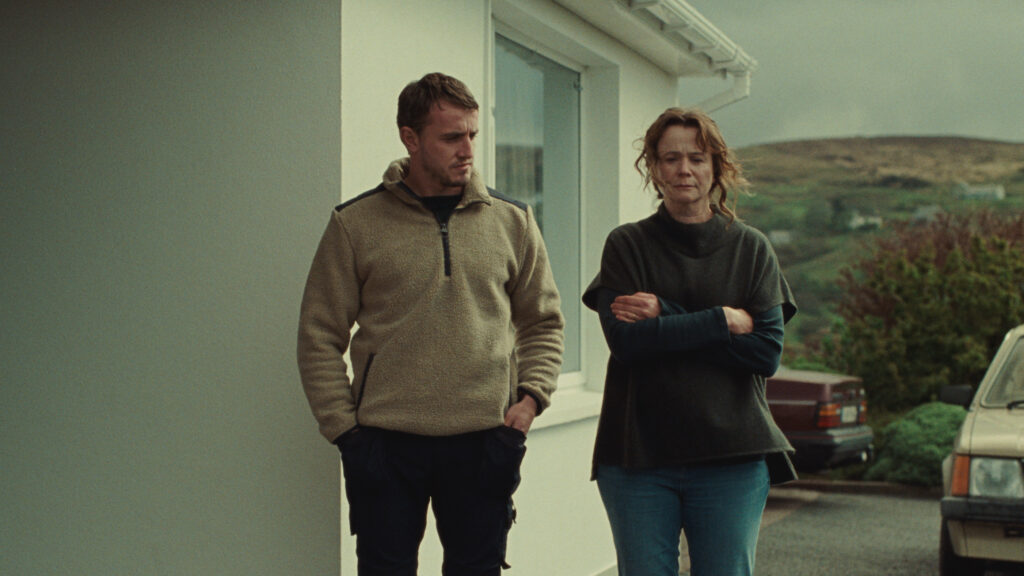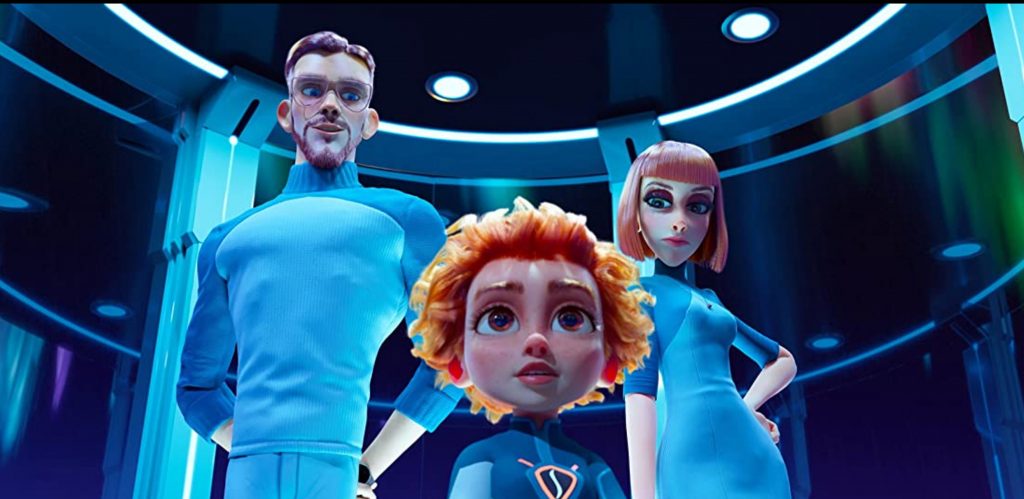October 22, 2022
by Carla Hay

Directed by Saela Davis and Anna Rose Holmer
Culture Representation: Taking place in an unnamed rural village in Ireland, the dramatic film “God’s Creatures” features an all-white cast of characters representing the working-class.
Culture Clash: A woman who manages her family’s oyster farm has to decide how loyal she wants to be to her son after he’s accused of raping one of her employees, and she tells a lie to create an alibi for him.
Culture Audience: “God’s Creatures” will appeal mainly to people who are fans of star Emily Watson and well-acted movies about moral dilemmas.

Despite its slow pacing, “God’s Creatures” is a very effective psychological drama that brings up ethical questions about family loyalty and dealing with sexual assault. Emily Watson gives an emotionally stirring performance as a conflicted mother who has to reckon with her own responsibility in possibly covering up a serious crime. It’s a movie that shows why denial can be just as toxic as a criminal act.
Directed by Saela Davis and Anna Rose Holmer, “God’s Creatures” (written by Shane Crowley) was filmed on location in County Donegal, Ireland. It’s here, in an unnamed fishing village, that Aileen O’Hara (played by Watson) thinks she’s living an uncomplicated life that revolves around her work and her family. Aileen has been happily married to her husband Con (played by Declan Conlon) for about 35 years. Together, they own an oyster farm, where Aileen works as a manager of the oyster processing plant. Con mainly supervises the oyster fishermen.
Aileen and Con have two children: Erin O’Sullivan (played by Toni O’Rourke) and Brian O’Hara (played by Paul Mescal), who are opposites in many ways. Erin, who has lived in the village her entire life, is in her 30s and is a single mother to an infant son. Brian, who is in his mid-to-late 20s, is a freewheeling bachelor with no children. For the past seven years, Brian lived in Australia and had stopped contacting his family. Near the beginning of the movie, Brian suddenly shows up in the village and expects to pick up right where he left off before he moved away to Australia.
The father of Erin’s baby is not in Erin’s life and won’t be involved in raising the child. Erin knows that many people in the community are religious and politically conservative. And therefore, she’s aware that being a single mother who is not widowed carries a certain stigma. Based on the fact that Erin has a different last name from her parents, it’s implied that she’s divorced. It’s not clear if her ex-husband is the father of her child or not, but Erin has told her family that the father of her child didn’t even know she was pregnant and therefore doesn’t know the child exists.
Brian is a prodigal son who was known as a troublemaker before he moved away to Australia. He is welcomed back with open arms by Aileen, who is very happy to see him. Con and Erin are much more wary and skeptical of Brian’s sudden reappearance. It’s open to interpretation why Brian suddenly wanted to move back to this small village. Was he running home to his family or running away from something?
Brian won’t really say why he suddenly decided to move back to his hometown without giving his family any advance notice. His family doesn’t press the issue, and he lives in Aileen and Con’s home. Brian is also quickly given a job as a fisherman in the family business. Although the O’Hara family is responsible for employing about 40 to 50 people in the village, the family lives modestly but is aware that the family has a certain amount of power in this community.
Con’s elderly father Paddy O’Hara (played by Lalor Roddy) also lives on the family property. Paddy, who is mute and might have dementia, passed on the family’s oyster business to Con, who promised Paddy that he would keep the business going. In his current mental state, Paddy is mostly unresponsive when people try to talk to him.
However, when Brian comes back to live in the family home, Paddy seems to light up when he’s around Brian. Brian is attentive to Paddy and helps take care of him like a dutiful and compassionate grandson. At one point, Brian is able to coax Paddy out of Paddy’s muteness, by getting Paddy to sing out loud.
It becomes obvious early on in the story that Aileen favors Brian over Erin. Brian has a very charismatic side to him where he shows that he can be outgoing and charming. He’s a “mama’s boy” who knows that Aileen is more likely than Con to forgive or overlook Brian’s flaws and misdeeds. As far as Aileen is concerned, whatever wrongdoings that Brian committed in the past, they should stay in the past. Aileen thinks Brian deserves a chance to prove that he’s turned his life around.
The opening scene of “God’s Creatures” is a subtle indication of how this village is rooted in traditions and superstitions. A fisherman named Mark Fitz, who worked for the O’Hara family, has been found dead in the sea, and his body has been taken out of the water. He drowned because he didn’t know how to swim. His mother Mary Fitz (played by Marion O’Dwyer) works in the processing plant. This drowning happened before Brian came back to the village to live.
The villagers traditionally don’t want their fishermen to know how to swim, so that if one of them is drowning, other people won’t be responsible for jumping in the water to save the drowning person. No one really questions this tradition, which is an indication that people in the community are willing to sacrifice others for a “survival of the fittest” mentality. As an example of Erin’s willingness to be a nonconformist in this tight-knit village, she tells her family that she’s going to teach her son how to swim.
One of Erin’s closest friends is Sarah Murphy (played by Aisling Franciosi), who works at the O’Hara family’s oyster processing plant. Like many people in the village, Sarah has lived there her entire life. Sarah, who is closer in age to Brian than she is to Erin, is a former schoolmate of Brian’s. She is trapped in an unhappy and abusive marriage to Francie D’Arcy (played by Brendan McCormack), who is very controlling and often accuses her of being unfaithful to him. Sarah having a different last name from her husband is an indication that she has an independent streak.
Sarah confides in Erin that due to her arguments with Francie, “I’ve been back in my parents’ house for a couple of nights. Time puts it all into perspective very quickly. He was brutal with his words. Still, though, he’s just like anyone else, though. We’re all God’s creatures in the dark.”
One night, Brian is hanging out at a local pub owned by a man named Dan Nell (played by Enda Oates), who is also the chief bartender. Sarah is there too, and Brian strikes up a flirtatious conversation with her. “I can’t believe you’re still here, to be honest,” Brian tells Sarah. “I thought you’d long abandon this place.”
Sarah replies, “Everything I need was here. I didn’t have to go looking for it.” Brian says, “Likewise.” This statement from Brian seems to be not very honest, since he obviously was looking for something somewhere else, by living in Australia for years and deliberately not contacting his family.
Brian then begins to reminisce about the good times that he and Sarah used to have when they were teenagers. Sarah curtly says about this reminsicing, “I wouldn’t get too hung up on it if I were you.” It’s implied that Brian has been attracted to Sarah for years. And now that he knows she’s in a troubled marriage, he wants to know if he has a chance with her. However, Sarah quickly shuts down this possibility.
About one week after this encounter, the O’Hara family business gets some bad news: Fungus has been found in some of the harvested oysters, so the fishing operations are temporarily halted. Around the same time, Sarah has been acting strangely on the job. On day, she faints near one of the conveyor belts, and when Aileen goes over to help her, Sarah says to her in a hostile manner: “Don’t touch me!”
Aileen will soon find out why Sarah is acting this way. One night, a garda named Mike (played by Andrew Bennett) visits the O’Hara family home to tell Aileen that a woman (whose name he won’t disclose) has accused Brian of raping her the week before. Brian has denied it and says that on the night in question of the alleged rape, he was at home all night, and Aileen can vouch for him. Mike asks Aileen if Brian’s alibi is true, and Aileen automatically says yes.
However, later when Aileen confronts Brian about where he was that night, he admits he was out in Dan Nell’s pub, where his accuser says that they were at, but that he had no sexual contact with her. Brian vigorously tells Aileen that he didn’t sexually assault anyone. It isn’t long before Aileen finds out that Sarah is Brian’s accuser.
Aileen believes Brian, so she feels resentment toward Sarah and thinks that Sarah is trying to ruin Brian’s life. Sarah feels resentment toward Aileen, because she thinks that Aileen is willfully covering up for Brian. Meanwhile, Erin is inclined to believe Sarah and doesn’t like it that Aileen refuses to hear Sarah’s side of the story. Needless to say, the tension builds when an investigation yields a result that is bound to make one side very unhappy.
“God’s Creatures” is a “slow burn” story where the last third of the movie is the best part. As soon as Aileen finds out that Brian doesn’t have an alibi for the period of time that he was accused of raping Sarah, the seeds of doubt have been planted in Aileen’s mind, but she tries to repress this doubt at all costs. Erin, who always felt like Aileen unfairly favored Brian over Erin, becomes increasingly infuriated with Aileen for what Erin thinks is misguided parental protection. Con stays out of this family conflict by not taking either side.
Meanwhile, Brian gets the support from many people in the community who think of him as a reformed “good guy,” and they want the rape accusation to go away. As for Sarah, coming forward with this rape allegation has made life much worse for her at her home and at work. She gets bullied and shamed by certain members of the community who think that she’s lying.
“God’s Creatures” is a scathing and often-melancholy rumination of how society often deals with sexual assault—a crime that is typically very hard to prove because there are usually only two witnesses: the accuser and the accused. If the accused admits to having sexual contact with the accuser, the accused usually says that this sexual contact was consensual. Sarah is blamed by some people for waiting a week to come forward with her accusation. It’s a common reaction from people who don’t know or don’t care that when an accuser chooses to comes forward is not proof of an accuser’s honesty or dishonesty about the allegation.
Watson gives a very nuanced performance as Aileen, who thinks of herself as a moral and upstanding person, but Aileen starts to question what kind of person she is the more she begins to doubt that Brian is telling the truth. Mescal probably has the hardest role to play, since the Brian character is supposed to keep viewers guessing up to a certain point if he’s a “good guy” or not. Franciosi has some standout moments in her role as Sarah, who finds out quickly that her entire reputation can change once she’s labeled a rape accuser.
The rape accusation causes a rift in the O’Hara family, as Erin makes it clear that she’s on Sarah’s side. However, the movie also shows how the accusation affects the entire community, not just the O’Hara family and Sarah. “God’s Creatures” is a depiction of how society can be complicit in enabling harm. And in this community, where the attitude is “survival of the fittest,” justice and peace often can’t be found in a court of law.
A24 released “God’s Creatures” in select U.S. cinemas on September 30, 2022.


